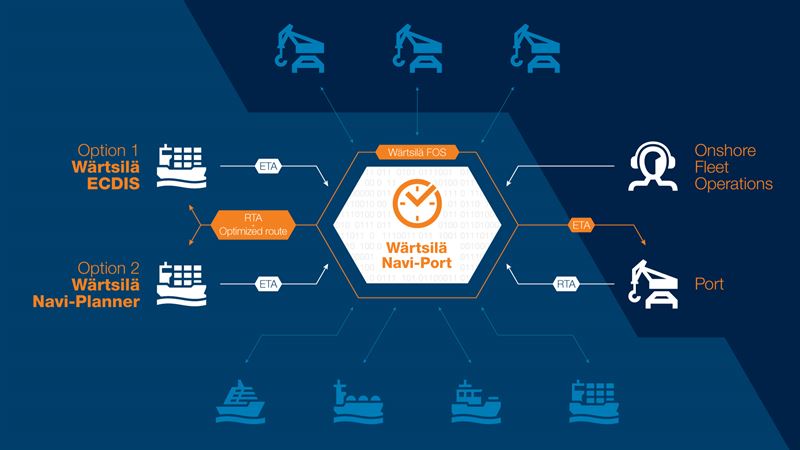Press Release: Today, the technology group Wärtsilä, together with project partners Carnival Maritime and HVCC Hamburg Vessel Coordination Center (HVCC), announced they have successfully implemented and tested a new solution for just-in-time sailing.
Together, the partners have achieved the seamless exchange of data between ship and shore under real-life conditions, thereby enabling optimal port arrival. Furthermore, the applied solution, Wärtsilä Navi-Port, has received approval in principle from Bureau Veritas Marine and Offshore for meeting the classification society’s cyber security requirements.
The untimely arrival of ships to port is a costly problem
Ships frequently sail faster than necessary in order not to miss valuable berthing slots, only to find themselves having to wait at anchor before the pilot station. This queuing is the result of a lack of relevant data sharing between vessels and their destination ports. The current modus operandi is often inefficient, which in turn can have a negative effect on doing business. The financial impact is considerable, while the unnecessary burning of fuel at higher speeds also adds to the levels of harmful emissions being exhausted into the atmosphere. This project targeted avoidable excesses of speed, on the basis that timing is everything.
Enabled by Wärtsilä Navi-Port
Wärtsilä Navi-Port is a middleware which will be hooked up to Wärtsilä’s Fleet Operations Solution (FOS) system. FOS is essentially an online infrastructure designed to enable 360° ship-to-shore reporting and fleet performance management. It combines individual processes that are otherwise separated, to optimise voyage planning, weather routing and fuel consumption, taking into consideration charter party compliance, speed management, as well as the condition of the hull, propeller and engine.
Wärtsilä Navi-Port now also facilitates the exchange of accurate arrival times between ports and ships, enabling vessels to automatically adjust speed to achieve a just-in-time arrival. Dynamic, real-time data sharing improves co-ordination, allowing for modifications to course and speed should conditions at the port change during a voyage. For the ports, the Wärtsilä system enables better and more efficient planning of port and terminal operations.
Automated communication significantly eliminates administrative burden
Wärtsilä Navi-Port is the first commercially available ship-to-port communication platform that has applied the port call message standard as defined by the Sea Traffic Management (STM) validation project. Wärtsilä has been one of the main contributors to the STM developments and trials, where more than 300 vessels have participated, 130 of which have used Wärtsilä navigation systems.
Today, nearly all the activity coordination from the port side happens via an agent, meaning there is a lot of point-to-point interaction. Connecting the port system with the vessel navigation system can automate correspondence and ease handling of all stakeholders involved in a ship’s safe and timely arrival to port.
How does it work?
If port conditions are incompatible with the vessel’s planned time of arrival, the berth scheduler suggests a new Requested Time of Arrival (RTA). The RTA is shared with Wärtsilä FOS and then sent directly to the vessel’s navigation system, along with an optimised, automatically calculated sailing speed. If the RTA is accepted by the Captain, the ship’s speed is automatically adjusted to respond to the new arrival time.
Depending on the specific decision-making process, the information can also be shared with the shipping company’s Fleet Operation Centre, so that shore-side personnel can be involved in the approval chain. The changed Estimated Time of Arrival (ETA) is constantly communicated to the port. The ship then arrives to the berth at the allotted time, having saved fuel and having emitted far fewer exhaust emissions.
“HVCC is responsible for the operational coordination of vessel traffic into and out of the Port of Hamburg in close collaboration with the relevant authorities. Terminals, shipping companies, and port service providers make use of our operational services for the arrival of large-sized-, feeder- and inland waterway vessels in the port, the rotation planning within the port, and departure coordination after handling. HVCC has already in past years been a frontrunner in terminal-carrier communication, and in 2019 distributed more than 3800 passage plans to our customers. The Wärtsilä Navi-Port enables seamless communication of data between ports and vessels. Ultimately, vessel approaches are even more efficient, resulting in reduced emissions,” says Gerald Hirt, Managing Director, HVCC.
“We are committed to making cruising more sustainable, and to setting an example in greener and safer operations. For this, we welcome the development of new and more efficient technologies, such as the Wärtsilä Navi-Port. We have tested the solution with two of our ships, the ‘AidaSol’ and the ‘AidaPerla’. The ships’ onboard Wärtsilä NACOS Platinum navigation systems were connected directly to HVCC, which allowed continuous communications, resulting in JIT arrivals in Hamburg. Outstanding!” says Michael Salzmann, Senior Nautical Superintendent, Carnival Maritime.
“Wärtsilä’s Smart Marine Ecosystem approach is aimed at eliminating wasteful practices in shipping operations, and the Navi-Port solution does just that. Collaboration between industry stakeholders is a key enabler to our approach, and once again, this project shows what can be gained when the industry works together in a transparent and cooperative way,” says Torsten Büssow, Director, Voyage, Wärtsilä.
“Connectivity is now enabling new ways of working. As a class society, Bureau Veritas plays a critical role in helping ensure that the marine industry safely adopts new technologies. BV initiated the Smart Ship Programme a few years ago, so it feels like a natural fit for us to be a part of this important JIT pilot,” says Najmeh Masoudi, Technology Leader- Smart ships, Bureau Veritas.
- Joint project between Wärtsilä, Carnival Maritime & HVCC Hamburg Vessel Coordination Center emphasises the benefits of real-time data exchange between ship and port
- New Wärtsilä system is the first commercially available ship-to-port product that enables dynamically optimised port approach and terminal berthing
- The applied solution has received approval in principle from Bureau Veritas for meeting the classification society’s cyber security requirements
- Just-In-Time (JIT) arrivals save fuel costs, reduce emissions, and support port operations
































